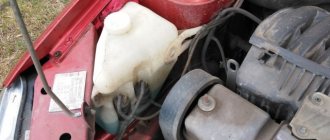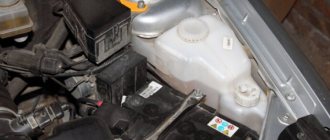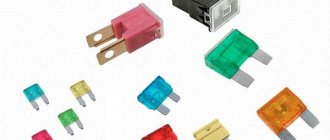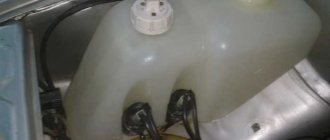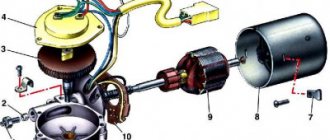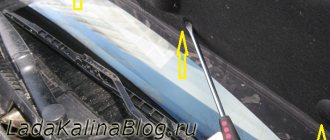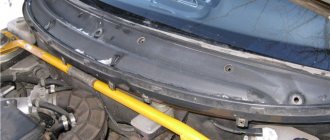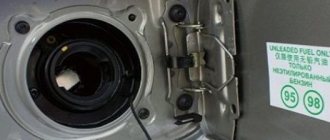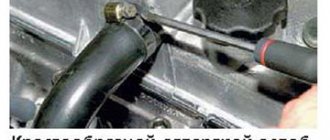Very often, the washer container in a car can crack and burst, since the material for it is plastic. If it cracks along the seam, the washer fluid will leak and result in a damp spot. It is not practical to repair the systems, so it is best to go to the store and buy the same new one. But to replace it, you still have to work on it yourself. How to remove the washer reservoir, how difficult is it, what is the fastening and procedure? The answers to these questions can be found in this article, without visiting a car service center. Different brands of cars require almost the same procedure, but it differs in some ways.
Removing the windshield washer pump and reservoir
We carry out work when the pump fails and the windshield washer reservoir is damaged (leaky).
Before removing the pump or reservoir, use a rubber bulb to remove fluid from the washer reservoir. Disconnect the wire terminal from the negative terminal of the battery. To remove the pump... ...disconnect the ends of the two wires from the pump terminals.
Use a screwdriver to pry up the pump...
...and remove the pump from the reservoir hole.
Remove the fluid supply hose to the washer nozzles from the pump nozzle.
Windshield washer pump.
The pump in the tank hole is sealed with a rubber bushing. We replace the torn or lost elasticity bushing with a new one. Install the pump in reverse order. We connect the ends of the wires to the pump terminals, the pink wire to “+”, the black wire to “–”. To replace the reservoir, remove the washer pump from it.
Using a 10mm socket, unscrew the nut securing the tank.
Remove the washer reservoir. Install the washer reservoir in the reverse order. Wherein…
...the protrusion on the tank should fit into the hole in the mudguard of the engine compartment.
Subscribe to topic
Notification by e-mail about replies to a topic during your absence from the forum.
Subscribe to this forum
Notification by e-mail about new topics on the forum during your absence from the forum.
Download/Print theme
Download the theme in various formats or view a printable version of the theme.
To ensure sufficient visibility when driving in bad weather, your vehicle's windshield wipers and washer system must function properly. The windshield washer pump delivers a stream of water that helps remove dirt that has accumulated on the glass. At first glance it seems that this detail is not very important. But when it rains, you will practically not be able to continue driving if the pump fails.
Instructions for removing the reservoir and washer pumps on the Lada Kalina
For this type of work, we will need a flat-blade screwdriver and a regular 10mm wrench. It will be necessary to unscrew one nut and one fastening bolt. We pry the pumps up with a flat screwdriver or even just pull them up with our hands and they are easily removed from the housing. Then you will need to disconnect the clamp that holds the hoses together. If this cannot be done, then you can simply cut it and then fasten it with a new one (they are sold in packs and cost mere pennies).
Now, after the bolt and nut are unscrewed and the pumps are removed, you can safely remove the tank itself. The photographs below show everything clearly, and everything is marked with arrows. To enlarge just click on the image:
If you also need to replace the pumps, then after removing them, disconnect the two hoses and power wires. When connecting new ones, keep in mind that the pink wire is positive and the black wire is negative.
How does a windshield washer motor work?
The motor in the windshield washer allows a stream of water or windshield cleaning liquid to be supplied under pressure. In some models, the jet is supplied not only to the front, but also to the rear window. It is not difficult to set up the operation of windshield washer parts, but when the motor breaks down, most car owners contact the service center to replace it. In fact, repairing a motor is quite easy, the main thing is to know a few secrets.
External view of the windshield washer motor
Washer failures, their causes and diagnosis
Most often, the cessation of fluid supply is due to clogged filters. Therefore, first of all, clean the system and eliminate the cause of the breakdown - contamination . If it turns out that the motor has stopped working, then you will need to clean its parts from rust and dust. Replacing the mechanism will only be necessary as a last resort. In some situations, electrical breakdowns occur. This is due to loss of contact on one of the connections. With frequent temperature changes, over time, the motor terminals oxidize, which leads to their complete or partial destruction. Most often, breakdown occurs due to:
- clogged washer nozzles;
- a broken hose;
- fluid leaks;
- washer switch malfunction;
- Damage to motor terminals.
Tip: First, inspect the windshield washer reservoir and clean the system of dirt, and only after that proceed to cleaning the motor.
Step-by-step replacement instructions
Despite the fact that different car models have distinctive windshield washer design features, the diagnostic and replacement process is similar. The repair will not take you much time. New components, if needed, are inexpensive and will cost you about 500 rubles. The tools you will need are a flathead and Phillips screwdriver and a set of standard wrenches.
- Using the technical manual for your model, we find the exact location of the tank and motor.
- Turn off the power supply. To do this, disconnect the wires that go to the pump.
Disconnect the wires that supply the windshield washer pump
Remove the tank after disconnecting the hose and fitting
Disconnect the windshield washer pump and clean it
When disassembling the pump, it may be discovered that the bushing has become unusable and needs to be replaced. Such a part is inexpensive and when repairing it is better to purchase it in advance to increase the service life of the mechanism.
How to replace (video tips)
If problems arise with the windshield washer, do not delay repairs. In bad weather, you cannot do without cleaning the windshield, and low visibility often leads to emergency situations on the road. Replacing the motor or cleaning it can be done on your own, it will take very little time.
Source
Replacing the motor
Replacing the washer pump on a Lada Priora is quite simple, using the instructions below.
The first thing you need to do is prepare the necessary tool:
- Ratchet with 10mm and 13mm heads
- Open-end wrench 10mm
Process
For convenience, we remove the battery, this will make replacement work more convenient.
- We unscrew the battery mount, then its seals and remove the battery.
- We remove the chips from the washer motor (in this case there are two of them).
- To diagnose the washer reservoir, it must be removed, and it is much more convenient to replace it with a removed reservoir. To do this, unscrew the two nuts securing the tank.
DIY windshield washer motor replacement
To ensure sufficient visibility when driving in bad weather, your vehicle's windshield wipers and washer system must function properly. The windshield washer pump delivers a stream of water that helps remove dirt that has accumulated on the glass. At first glance it seems that this detail is not very important. But when it rains, you will practically not be able to continue driving if the pump fails.
VAZ washer reservoir: a clean windshield in any situation
Every car of the Volzhsky Automobile Plant has a windshield washer - a simple and convenient thing, without which it is no longer possible to imagine the safe operation of the car. One of the central components of the washer is the reservoir - read the article about this part, its purpose, design and repair.
A general look at windshield washers for VAZ cars
Windshield washer is an auxiliary system of a car that cleans the windshield or other windows from various contaminants while driving. The presence of a washer allows you to quickly wash away dust, dirt or traces of insects without slowing down or taking time to stop. All modern cars are equipped with these systems, including models from the Volzhsky Automobile Plant.
The first Zhiguli models - VAZ-2101, 2102 and their various modifications - were equipped with manual windshield washers. They consisted of an elastic tank in the engine compartment (the tank was nicknamed a “hot water bottle” due to its characteristic shape), two nozzles, a system of tubes and a hand pump made in the form of a button.
If you needed to wash the window, you had to press the button frequently, which was not entirely convenient. At the same time, the VAZ-21011 car used a foot-operated washer - in it the pressure pump was driven by the foot.
Since 1980, a foot-operated washer began to be used on these cars, and an electrically driven windshield washer was installed for the first time on model 21011. Somewhat later, all VAZ cars began to be equipped with electric washers.
How does a windshield washer motor work?
The motor in the windshield washer allows a stream of water or windshield cleaning liquid to be supplied under pressure. In some models, the jet is supplied not only to the front, but also to the rear window. It is not difficult to set up the operation of windshield washer parts, but when the motor breaks down, most car owners contact the service center to replace it. In fact, repairing a motor is quite easy, the main thing is to know a few secrets.
External view of the windshield washer motor
Washer failures, their causes and diagnosis
Most often, the cessation of fluid supply is due to clogged filters. Therefore, first of all, clean the system and eliminate the cause of the breakdown - contamination . If it turns out that the motor has stopped working, then you will need to clean its parts from rust and dust. Replacing the mechanism will only be necessary as a last resort. In some situations, electrical breakdowns occur. This is due to loss of contact on one of the connections. With frequent temperature changes, over time, the motor terminals oxidize, which leads to their complete or partial destruction. Most often, breakdown occurs due to:
- clogged washer nozzles;
- a broken hose;
- fluid leaks;
- washer switch malfunction;
- Damage to motor terminals.
Tip: First, inspect the windshield washer reservoir and clean the system of dirt, and only after that proceed to cleaning the motor.
How and what to fill in the washer reservoir?
Above we looked at how to remove the washer reservoir, check the system sensor and change the container (if it is damaged). But there are situations when the container body is intact, and the only thing that needs to be done is to add liquid.
In such a situation, proceed as follows:
- Pull the hood handle located in the cabin.
- Open and secure the hood.
- Unscrew the cap that is installed on the tank. In this case, unscrew only the cover that does not have wires.
- Add liquid (water or anti-freeze). If the container is empty, it holds about five liters.
An equally important question is what to put in the tank. It is important to consider the time of year here. So, in winter it is recommended to pour non-freezing liquid, which will protect the system from freezing.
Watch the video on how to remove the washer reservoir.
As for the summer period, water with the addition of a cleaning additive is suitable. To ensure the best effect, first pour the additive into the container, and then add water. With this sequence, the liquids mix more easily and quickly. Good luck on the roads and of course no breakdowns.
Step-by-step replacement instructions
Despite the fact that different car models have distinctive windshield washer design features, the diagnostic and replacement process is similar. The repair will not take you much time. New components, if needed, are inexpensive and will cost you about 500 rubles. The tools you will need are a flathead and Phillips screwdriver and a set of standard wrenches.
- Using the technical manual for your model, we find the exact location of the tank and motor.
- Turn off the power supply. To do this, disconnect the wires that go to the pump.
Disconnect the wires that supply the windshield washer pump
Remove the tank after disconnecting the hose and fitting
Disconnect the windshield washer pump and clean it
When disassembling the pump, it may be discovered that the bushing has become unusable and needs to be replaced. Such a part is inexpensive and when repairing it is better to purchase it in advance to increase the service life of the mechanism.
How to replace (video tips)
If problems arise with the windshield washer, do not delay repairs. In bad weather, you cannot do without cleaning the windshield, and low visibility often leads to emergency situations on the road. Replacing the motor or cleaning it can be done on your own, it will take very little time.
Source
Where is the washer fluid container located?
Novice car owners often do not know where the washer reservoir is located. They often confuse it with a coolant or brake fluid container. In fact, finding the tank you are interested in is not difficult.
Let’s say in VAZ cars it is located under the hood, on the left or right side of the engine, depending on the model, and there may also be two of them, on the rear and front windows. And on foreign cars it can be located under the front bumper.
If the level of water or antifreeze in the tank is insufficient, it is enough to top up. But what to do when the windshield washer reservoir bursts? In such a situation, the only salvation is to replace the failed device.
How to replace the washer reservoir:
Lift the hood and find the sensor that monitors the washer fluid level (not found on all cars). Disconnect the connector that fits this device. Also, disconnect the connectors from the wires from the electric pump that pumps up the washer fluid. At the same time, remove the wires from both pumps - for the windshield and for the rear.
Then remove the washer reservoir from its mounting and remove the tubes from the fittings of both pumps. Remove electric pumps from the container. To do this job, you will have to overcome a certain force created by the sealing bushings.
Carefully pry the said sleeve (you can use a flat head screwdriver or something similar) and then remove it from the hole in the container. Assess the condition of the bushing for elasticity. If it is damaged, replace it.
Unscrew the cap and remove from the container the sensor that controls the level of windshield washer fluid (if, of course, your car has one). Check the functionality of the sensor. To perform this task, connect a test lamp to its connectors, then power the device with 12 Volts.
If the float is at the bottom (that is, it signals the absence of liquid), the light should light. Now lift the float up and control the behavior of the light bulb - there should be no glow. If the algorithm is not the same as described above, the sensor needs to be replaced.
Washer fluid level sensor
This completes the removal of the washer reservoir. Next, you need to decide whether you will change the device or try to make a repair, that is, seal it. The first option is more preferable. And the cost of the product is not so high as to save.
Now replace the container and follow the reverse order. If problems arise with the installation of electric motors, and they are difficult to fit through the seals, use soap to lubricate the edges.
Once the tank and motors are mounted, return the nozzle pipes to their place. To simplify the process of installing the tube on an electric motor, heat the tip of the tube with a lighter, after which they can be easily put on. During installation, ensure that the motor is securely fixed.
Why is the nozzle not spraying?
The washer pump fuse has blown. You can find out the location of the fuse link that protects the electric motor circuit from the repair and operation manual. Very often, on the plug covering the mounting fuse block, the manufacturer, using graphic symbols, indicates the number of the fuse link and the consumer whose circuit it breaks in the event of a short circuit. If you have to change the fuse frequently to operate the washer, there is a short circuit in the circuit.
Instead of a burnt-out insert, install only a fuse of the appropriate rating. Installing fuses designed for high current can result in a vehicle fire.
- The pump has failed. A breakdown can be caused by blocking the rotation of the impeller wheel with dirt or corrosion. The power of the electric motor is not enough to rotate the armature shaft of the electric motor. In some types of construction, corrosion and dirt block the rotation of the motor armature.
- The washer nozzle sprays poorly or does not spray at all, as the nozzle channel is clogged. The cause of the malfunction is corrosion of the channels inside the nozzle and debris entering the tank.
- Motor circuit malfunction. Failure of the steering column switch, an open circuit due to damaged wires, or the formation of oxides on the terminals are the most likely reasons why the windshield washer does not work.
- The hose has torn, broken, or jumped off the pump fitting. Carefully inspect the transition of the hose from the engine compartment to the hood, the secure fit of the hoses to the fittings of the injectors and washer pump.
- The washer fluid in the reservoir has frozen.
Principle of operation
The windshield and rear window cleaning system is based on an electrically driven pump. The armature shaft of the motor is connected to a paddle wheel, which, when rotated, supplies washer fluid through hoses to the windshield washer nozzles. The sealing collar prevents washer fluid from entering the electric motor. It is the leakage that becomes the main reason why the windshield washer pump does not work. Water and glass washer fluid getting inside start the corrosion process, deteriorating the quality of the contacts and increasing the resistance to rotation of the pump armature.
A DC motor is used as a motor. There are at least 2 types of design:
- the pump body is also the body of the electric motor, so permanent magnets are attached to it;
- A separate motor is used, which is assembled and installed in the windshield washer housing.
In most systems, separate pumps are installed for different circuits. But in some cars, one electric motor can wash both the rear window and the windshield. In this case, the direction of fluid supply depends on the polarity of the voltage supplied to the electric motor. For variable supply of liquid in different directions, a check valve is used in the design.
Finding the cause of the breakdown
To determine the breakdown due to which the glass washer has stopped working, use the method of elimination.
- Turn on the windshield washer (there is no need to start the engine, just turn on the ignition). Listen for a buzzing sound coming from where the tank is installed, indicating that the electric motor is turning on. If the motor hums, look for the cause of the failure in the hoses and injectors.
- The electric motor does not turn on. Disconnect the pump connector. If there is enough space around the reservoir, the pump can be checked without removal. To check why the motor is not working, it is enough to directly supply power to its contacts from the battery. To do this, you will need two pieces of wire, one end of which is attached to the positive and negative terminals of the battery. Using the mating parts of the wires, briefly touch the terminals of the windshield washer motor. If there is no immediate reaction, apply voltage in a mirror manner (you can avoid this error if you first study the circuit diagram for turning on the pump on your car). If the motor works, the washer does not work due to problems in the control circuit. Otherwise, the reason is in the pump itself.
Circuit Diagnostics
The voltage is checked by a control. To test the circuit for a break, you will need knowledge of the rules for using a multimeter and the universal meter itself.
- Turn on the ignition.
- Attach one control pin to the part in contact with the unpainted part of the body.
- Ask an assistant to turn on the washer or lock the steering column switch in the appropriate position.
- With the second control contact, touch the pin of the pump power connector, which should have +12 V when the glass washer is running. The ground is checked in a similar way, only you need to move the control contact from the metal part to the positive terminal of the battery.
If the motor is working properly, but the washer does not work, then you will definitely find a lack of power or ground. Next, you need to study the electrical circuit and identify all the elements that affect the operation of the windshield and rear window washer. Use a multimeter in resistance mode to check the wiring. Start diagnostics from the sections of the circuit that are most accessible for diagnostics. When disconnecting the connectors, pay attention to the presence of oxides that negatively affect the operation of the windshield and rear window washer.
How to remove the washer reservoir and replace it
Driving in rainy weather is always associated with risk - visibility through the windshield deteriorates, the risk of losing control when entering a puddle increases, and the quality of contact between the tire and the road decreases.
But the situation gets worse when the glass washer system fails. How to remove the washer reservoir
There can be many reasons - the electric pump has failed, the washer reservoir is damaged, or it has run out of washer fluid. In such a situation, dirt from under the wheels of the cars in front clogs the windshield, and if the system is not working, there is nothing to wash it with.
The result is reduced visibility and the risk of an accident. In such a situation, it is important to diagnose the device and fix the problem, namely, add fluid or replace the washer reservoir. Where this container is located and how to replace it will be discussed below.
Design features of the washer reservoir
A tank with water or “anti-freeze” is a white container installed in the engine compartment and intended for storing washer fluid. Moreover, the tank itself is one of the elements of the windshield washer system.
In addition to this, the device includes the following components:
- Washer jets (nozzles).
- A pressure pump that pumps liquid to the windshield from a container.
- Tubes between the jet and the motor (they supply water or an antifreeze compound).
- A special sensor that monitors the fluid level in the system and issues a corresponding signal to the driver.
- Mounting bracket, as well as tank plug.
- Special tee.
Where is the washer fluid container located?
Novice car owners often do not know where the washer reservoir is located. They often confuse it with a coolant or brake fluid container. In fact, finding the tank you are interested in is not difficult.
Let’s say in VAZ cars it is located under the hood, on the left or right side of the engine, depending on the model, and there may also be two of them, on the rear and front windows. And on foreign cars it can be located under the front bumper.
If the level of water or antifreeze in the tank is insufficient, it is enough to top up. But what to do when the windshield washer reservoir bursts? In such a situation, the only salvation is to replace the failed device.
How to replace the washer reservoir:
Lift the hood and find the sensor that monitors the washer fluid level (not found on all cars). Disconnect the connector that fits this device. Also, disconnect the connectors from the wires from the electric pump that pumps up the washer fluid. At the same time, remove the wires from both pumps - for the windshield and for the rear.
Then remove the washer reservoir from its mounting and remove the tubes from the fittings of both pumps. Remove electric pumps from the container. To do this job, you will have to overcome a certain force created by the sealing bushings.
Carefully pry the said sleeve (you can use a flat head screwdriver or something similar) and then remove it from the hole in the container. Assess the condition of the bushing for elasticity. If it is damaged, replace it.
Unscrew the cap and remove from the container the sensor that controls the level of windshield washer fluid (if, of course, your car has one). Check the functionality of the sensor. To perform this task, connect a test lamp to its connectors, then power the device with 12 Volts.
If the float is at the bottom (that is, it signals the absence of liquid), the light should light. Now lift the float up and control the behavior of the light bulb - there should be no glow. If the algorithm is not the same as described above, the sensor needs to be replaced.
Pump repair or replacement?
The feasibility of repair is determined by the cost of a new pump. A large number of pumps are non-separable, so for repairs you will have to cut them and then glue the plastic case together. To repair it yourself, it is enough to completely disassemble the motor, clean its insides from dirt, corrosion and growths.
Of course, you won’t find spare parts for the washer pump, so the sealing lip will remain old. If it was this that caused the jamming, then within a year the windshield washer will most likely not work again.
How to remove and wash injectors
The windshield washer nozzles are held in place by plastic clips. To remove the injector without damaging the body, check its number in the original spare parts catalog. By finding a photo of the injector by number, you will see exactly where the latches are located. You can remove the nozzle with a thin slotted screwdriver.
For cleaning, you can use a needle smaller than the diameter of the sprayer hole. We recommend that you first leave clogged injectors in a citric acid solution for some time. After soaking, the deposit can be removed using carburetor cleaner or compressed air.
Driving a car turns into torture if the windshield is covered with streaks of dirt. Trying to see what is happening ahead, the driver gets tired and has less control over the situation on the road. And the wipers scratch the glass, spreading abrasive dirt over it. Let's look at the most common faults. Perhaps, after reading this article, you will be able to independently cope with diagnostics and repairs right in the yard of your home. Let’s discuss several points at once so as not to repeat ourselves many times in the future:
- a description of the method for finding the cause of the malfunction will be presented continuously. That is, we will assume that the breakdown has not yet been fixed. If everything works for you, complete the repair.
- If any actions are beyond your competence or the necessary tools and spare parts are not available, go to a store or car service center.
Windshield washer pump does not work
The washer pump, as a rule, is made in a single housing with an electric motor and is installed in the fluid reservoir, so its operation is accompanied by a characteristic buzzing sound audible from the cabin. Turn on the ignition without starting the engine and press the steering column switch lever. If “there is silence in response,” it means the windshield washer motor did not turn on.
Troubleshooting sequence:
- checking (replacing) the windshield washer pump fuse
- checking the voltage supply fuse with a probe
- relay check. If it is working properly, you will hear a slight click when it operates.
- checking the voltage supply to the relay
- relay replacement
- “continuity” of wiring from the steering column switch
- checking the voltage supply to the pump
- search for broken wiring
- pump replacement
How to remove the windshield washer pump
Let's look at how to remove the windshield washer pump. First of all, you need to provide access to it. On domestic cars, the reservoir with a pump is installed in the engine compartment. Owners of foreign cars have to remove the fender liner, at least partially, in order to get to it. But there are also cars in which the engine is accessible only when the front bumper is removed. On some cars, it is enough to remove the plastic boot between the bumper and the fender liner. Sometimes a removable hatch is provided in the fender liner, which greatly simplifies repairs.
The pump is inserted into the tank with a suction fitting through a rubber seal. If you have checked the power supply to the electric motor, remove the pump.
Remove the tube before removing the pump - there is a risk of breaking off the outlet fitting.
Just make sure you are not removing the rear window washer motor. The headlight washer features noticeably larger diameter hoses with quick-release fittings.
If the motor does not show signs of life, change it, since repairing it is a thankless task, unless you have Left-handed abilities.
Design features of the washer reservoir
A tank with water or “anti-freeze” is a white container installed in the engine compartment and intended for storing washer fluid. Moreover, the tank itself is one of the elements of the windshield washer system.
In addition to this, the device includes the following components:
- Washer jets (nozzles).
- A pressure pump that pumps liquid to the windshield from a container.
- Tubes between the jet and the motor (they supply water or an antifreeze compound).
- A special sensor that monitors the fluid level in the system and issues a corresponding signal to the driver.
- Mounting bracket, as well as tank plug.
- Special tee.
This is interesting: Removing and installing the Kalina front seat
Windshield washer does not work well
“Bad” means that the pump hums, but the liquid almost does not reach the glass or splashes in different directions. Causes:
- clogged injectors, tubes, filter, check valve
- the tubes may have come off the injectors or connectors
- breakdown of pump fittings, connectors, nozzles
Start troubleshooting by disconnecting the tube leading from the pump to the injectors. If the jet pressure is good, then inspect the nozzles and pipe connections. Otherwise, “go down,” i.e. to the tank, and check the condition of the pump outlet fitting and tube, and also turn on the washer and evaluate its performance by eye. If the fitting is broken, compare your skills and the cost of the part. At times, repairing a fitting is useful and provides good savings in money and time - although sometimes you have to wait quite a long time for the ordered spare part.
Windshield washer nozzle
Briefly about how to remove windshield washer nozzles to clean them. If the object (mote) is larger than the diameter of the nozzle, then the obstacle from the outside can be pushed deeper into it, and it will “come back”. The injectors are usually fixed with elastic latches that need to be squeezed. It is convenient when the injectors are installed on the hood - the latches can be squeezed from the inside.
To remove the nozzle from the windshield wiper cover, you need to use a tool like a thin, flat, wide screwdriver.
Alternately prying the nozzle on both sides, pull it out along with the tube. If you are not sure what will happen, remove the overlay (“frill”). It is not at all necessary to remove the wiper arms - just bend the trim.
After removing the nozzle, use a pin or something similar to remove the blockage and blow (rinse) the nozzle in the opposite direction. You can also clean and wash the windshield washer fan nozzles, just try to remove dirt from all the jets. You can soak them in a soap solution, or better yet, soda ash. If the injector body is detachable, disassemble it, but be careful - there may be a check valve with a ball and a spring. The valve holds water in the tubes, so that when the washer is turned on, the liquid is immediately supplied to the glass and the wipers do not scrape dry dirt. When you put the nozzles in place, use a pin to adjust the direction of the jet, just do not damage the hole.
How to remove the washer reservoir on a viburnum?
You can check the serviceability of the electric windshield washer pump by applying 12 V voltage directly from the battery to its terminals. A faulty pump must be replaced.
1. We prepare the car for work.
If there is a lot of non-freezing liquid in the tank, in order to save money, you can remove the washer reservoir (see below) and, without removing the electric pump from it, pour the liquid into a canister.
2. We disconnect the two wire blocks from the windshield washer electric pump (after first marking the block connected to the terminal).
3. Using a screwdriver, remove the electric pump from the hole in the tank and disconnect the elastic tube from the pump.
4. We check the condition of the rubber seal installed in the opening of the tank. If replacement is necessary, remove the seal and install a new one.
5. Similarly, remove the electric rear window washer pump.
Installation
We install the electric windshield washer pumps in the reverse order.
To ensure sufficient visibility when driving in bad weather, your vehicle's windshield wipers and washer system must function properly. The windshield washer pump delivers a stream of water that helps remove dirt that has accumulated on the glass. At first glance it seems that this detail is not very important. But when it rains, you will practically not be able to continue driving if the pump fails.
If the windshield washer does not work in winter
Windshield washer does not work in winter
In winter, the reasons for washer failure may be the same as in summer, but they are added to those associated with freezing of the liquid. On modern cars, the washer reservoirs are located outside the warm engine compartment; the diluted “anti-freeze” can turn into a mess of ice crystals. Do not dilute it unless meteorologists predict it will be warmer than 5 degrees below zero.
Do not use diluted windshield washer fluid in winter.
If the liquid is frozen in the tubes, then no amount of heating of the injectors will help. The most effective way is to remove all the tubes with injectors and warm them up. But it’s better to find a friend with a warm garage and after “thawing”, bleed the system with undiluted winter windshield washer fluid.
Health is more expensive, and you can “break wood” by working with numb fingers.
Perhaps not everything is covered in this article, but it can serve as a catalyst and you yourself will find your own creative solution to the problem.
A very unpleasant situation can happen on the road if your windshield washer does not work. Moreover, you can find out about this right at the moment of a growing problem, when your glass is very dirty and you can hardly see anything. Well, we stop, turn on the emergency lights, wash the glass manually and go to the garage to figure out what the problem is.
Why did it happen so?
Perhaps the automatic requests do not belong to you, but to another user accessing the network from the same IP address as you. You need to enter the characters into the form once, after which we will remember you and be able to distinguish you from other users exiting from this IP. In this case, the page with the captcha will not bother you for quite a long time.
You may have add-ons installed in your browser that can make automatic search requests. In this case, we recommend that you disable them.
It is also possible that your computer is infected with a virus program that is using it to collect information. Maybe you should check your system for viruses.
If you have any problems or would like our support team, please use the feedback form.
ADDING FLUID INTO THE WINDSCREEN WASH RESERVOIR FOR LADA KALINA
To add liquid
. Unscrew the filler cap of the tank.
When adding fluid, check the level through the filler neck.
At ambient temperatures of 0 °C and below, it is recommended to fill the washer reservoir only with a special windshield washer fluid or concentrate diluted with water in the required proportions. Water or highly diluted windshield washer fluid may freeze in the reservoir, lines, or washer nozzles. Pure water is permissible for use only in the warm season.
Windshield washer - is it convenient without it?
The glass can become so dirty that an emergency stop is required even in dry sunny weather, let alone winter driving on city and highway roads. If it’s raining outside, even with the washer not working, you can brush off the dirt with the wiper blades, since the glass is already wet. Even during snow, this is possible when the snow melts slightly from the warm glass. But when a sunny winter day is darkened by splashes from under the wheels of cars in front, and the washer system has malfunctioned, you don’t really want to rub dirt on the glass, this will quickly lead to a huge number of scratches, and visibility will not significantly improve.
There may be several reasons for such unexpected desertion of your car, for example, simple negligence on your part when you forgot to promptly fill the windshield washer reservoir with water or a special liquid, or a breakdown in the system itself. We will try to figure out where to look and what to do if such a situation occurs. But first, we will learn the general rules for operating the system, which will exclude your negligence as the cause of the non-working condition.
Without going into details about the structure of the washer, you should remember a few rules, the implementation of which will ensure that you can clean the windshield at any time. Firstly, do not forget to periodically add water to the tank, because it can simply run out, then the emergency situation will be on your conscience. Secondly, during the winter season, do not forget to promptly change the water to a special non-freezing windshield washer fluid. At the same time, make sure that the maximum temperature for its operation corresponds to your region.
Removal instructions
The washer reservoir can become damaged for various reasons. If frost sets in and you forgot to fill in the frost-resistant liquid, in the morning there is a chance to see a burst container under the hood that will have to be replaced. The quality of the washer fluid is also not the best, which can lead to the same result. Regardless of the reasons, the burst reservoir must be removed from under the hood. This job has its own procedure, which differs depending on the make of the car. The fastenings can be either different or similar, and for work most often you need a flat-head screwdriver, as well as 10 and 13 keys.
Repairing an old tank is possible, however, the money and time spent on it are not always worth it. To put it more clearly, even a repaired tank will not perform all the functions assigned to it, it will look less aesthetically pleasing, and the service life after repair will still be reduced, because the wear of the plastic can be great. If possible, you should not neglect repairs. For older cars, repairs are acceptable; everything will work fine until it wears out completely. If you do not want to give preference to repairing this part in your car, it is best to go to the store.
There is a good chance you will find a tank that will fit your car according to its characteristics, and will be even larger in size. If the product is not the original model, it will be even cheaper, and in terms of characteristics – no less productive. There are tanks with a sensor for washer fluid and they are not difficult to buy. If the fasteners match, then the new system can be installed, even if its shape is slightly different from the original system previously installed in the car. If you want to maintain the make and equipment of your car, look for a tank that looks the same as yours.
How to change windshield washer fluid correctly?
I would like to talk separately about changing fluids. First, carefully dilute the concentrate if you prefer it, and this should be done before pouring it into the tank. Although many people pour the first portion of liquid directly into the system, hoping to somehow mix it with the water that is already inside. This step is incorrect, you do not know how much water there is, and the resulting concentration may not be enough, and the liquid will also freeze at the first minus on the thermometer. Water is inexpensive, pump it out completely, and fill it with “anti-freeze” in a concentration you already know. It’s best to buy a ready-made mixture, not a concentrate, and first test a small portion of the liquid in the freezer at home. Counterfeits of these products are far from uncommon.
Many owners do not have time to make a replacement in time, at least at 5 degrees Celsius, and this is an indicator of the night temperature. That is, you are guaranteed that the water in the tank should not freeze at any time of the day. If your system finds itself in a zone of freezing temperatures, even for one night, the windshield washer motor may become frozen and may not freeze immediately. And adding anti-freeze or its concentrate on top of the water in the system will not always lead to mixing of the components, as car enthusiasts expect.
The thing is that a piece of ice can form in the tank, and even worse if there is an air bubble inside. And no one can guarantee that at the time of adding the concentrate, this ice had time to thaw, even if the windshield washer motor is already pumping water, albeit with little pressure. It will turn out something like this: the concentrate will hang in the upper part of the tank, without mixing with the water that is in the lower part, under the ice. Then the water will freeze again at night, melt during the day, but not completely, the pump will pump it onto the glass, but it will not mix with the “anti-freeze” again.
And this endless circle will happen constantly until the water completely thaws, and if winter has already begun fully, this can only happen in the spring, or you will have to ask for a warm parking lot for an impressive number of hours in order to completely melt the ice.
